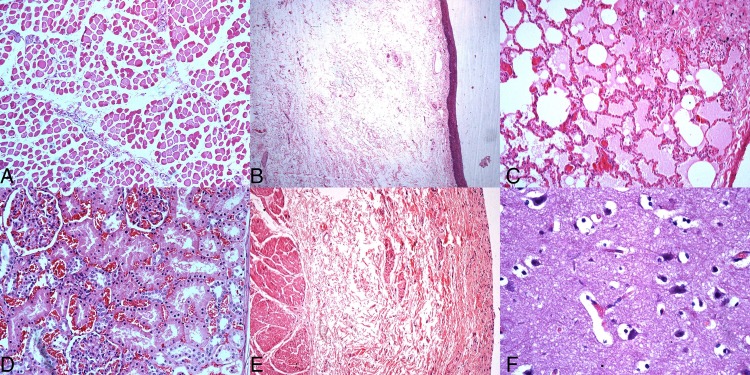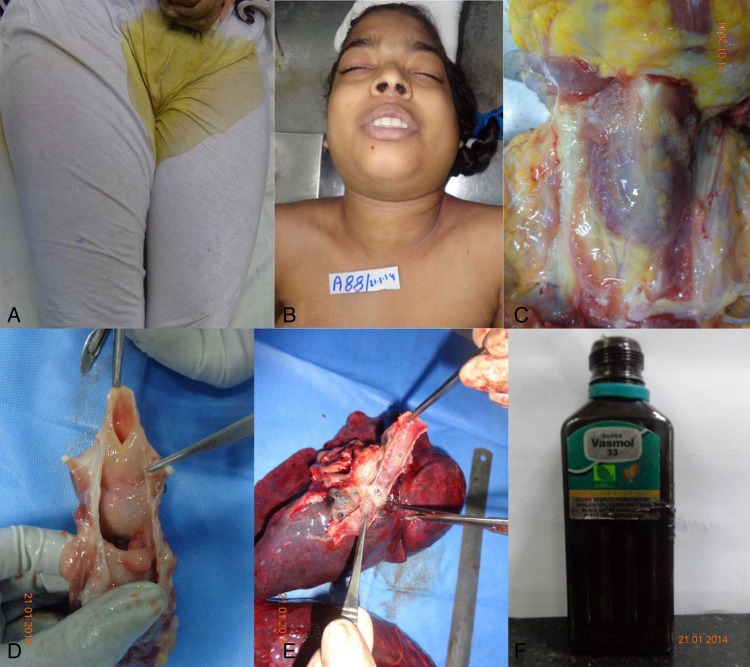Description
A 16-year-old girl was brought to the emergency department in a state of shock after consuming hair dye. Cardiopulmonary resuscitation was given along with other resuscitative measures, but the patient could not be revived.
At autopsy, a yellowish brown urine stain was observed on the girl's pyjamas and underwear in the pubic region (figure 1A). Oedema was present over the upper neck, lower face and lips (cervicofacial oedema; figure 1B). On dissection of the neck tissue, fluid was oozing from subcutaneous tissues and muscle (figure 1C). Oedema was also present in the larynx wall and the lumen had narrowed (figure 1D). Both lungs showed oedema and increased weight (figure 1E). The hair dye (Super Vasmol 33) bottle recovered by the police from the victim's home is shown (figure 1F).
Figure 1.
(A) Yellowish brown urine stain. (B) Cervicofacial oedema. (C) Oedema fluid in subcutaneous tissue and muscles of the neck. (D) Oedema in laryngeal wall and narrowing of lumen. (E) Oedema fluid oozing out from lung. (F) Vasmol hair dye bottle.
Histopathology of organs: Muscles of the neck showed prominent interstitial oedema (figure 2A). Larynx and epiglottis showed marked oedema in submucosal connective tissue (figure 2B). There was oedema, with capillary congestion in the interalveolar septae of the lungs (figure 2C). In the kidney, there was marked peritubular capillary congestion in the cortex as well as medulla (figure 2D). The liver showed sinusoidal congestion and mild microvesicular steatosis. Marked capillary congestion in the lamina propria and superficial mucosal erosion was found in the stomach wall. Sections from the thyroid showed oedema in interstitium. The urinary bladder revealed denudation of surface mucosa with oedema in the lamina propria (figure 2E). The heart showed mild capillary congestion. The spleen showed red pulp congestion. The brain showed shrunken neurons with eosinophilic cytoplasm, smudging of nuclear chromatin and pericellular retraction artefacts. These histological features are suggestive of hypoxic changes in brain tissue (figure 2F).
Figure 2.

(A) Interstitial oedema in muscles of the neck. (B) Oedema in submucosal connective tissue of epiglottis. (C) Oedema and capillary congestion in interalveolar septae of lungs. (D) Peritubular capillary congestion in cortex as well as medulla of kidney. (E) Denudation of surface mucosa with oedema in the lamina propria of urinary bladder. (F) Brain showing shrunken neurons with eosinophilic cytoplasm, smudging of nuclear chromatin and pericellular retraction artefacts (H&E ×100).
The hair dye contains paraphenylenediamine (PPD), a poison commonly used for suicide in developing countries.1 The diagnosis is made on the basis of classical clinical features, history of ingestion and laboratory investigations.1 2 The classical clinical features are cervicofacial oedema, severe rhabdomyolysis and renal failure. Cases are well reported by clinicians, however, characteristic findings at autopsy are rarely reported;3 hence we report the characteristic autopsy findings of Vasmol hair dye poisoning in a 16-year-old girl who deliberately ingested it.
Learning points.
Cases of hair dye poisoning are well reported by clinicians in developing countries, however, characteristic findings at autopsy are rarely reported.
A diagnosis of poisoning can be made on the basis of characteristic findings at autopsy.
Public awareness regarding potential lethality of hair dye poisoning is essential.
Footnotes
Contributors: CB conceived of the article. The autopsy was conducted by RK. ARM reported the histopathology. All authors were involved in the preparation of the manuscript. CB, TM and ARM edited and coordinated the writing of the manuscript. CB double checked the manuscript. All authors read and approved the final manuscript for publication.
Competing interests: None.
Patient consent: Obtained.
Provenance and peer review: Not commissioned; externally peer reviewed.
References
- 1.Chrispal A, Begum A, Zachariah A. Hair dye poisoning-an emerging problem in the tropics: an experience from a tertiary care hospital in South Delhi. Tropical Doctor 2010;40:100–3 doi:10.1258/td.2010.090367 [DOI] [PubMed] [Google Scholar]
- 2.Garg SK, Tiwari R, Ahlawat A. Hair dye poisoning: an unusual encounter Indian. J Crit Care Med 2014;18:402–4. [DOI] [PMC free article] [PubMed] [Google Scholar]
- 3.Belton AL, Chira T. Fatal anaphylactic reaction to hair dye. Am J Forensic Med Pathol 1997;18:290–2 doi:10.1097/00000433-199709000-00012 [DOI] [PubMed] [Google Scholar]



